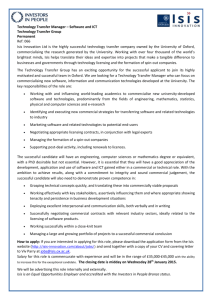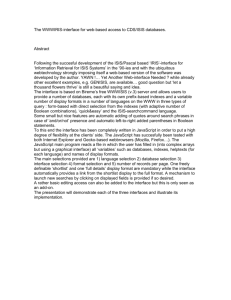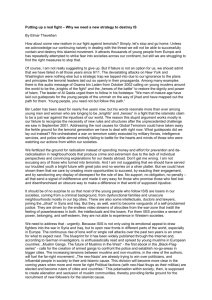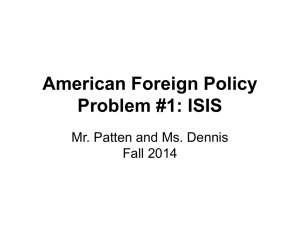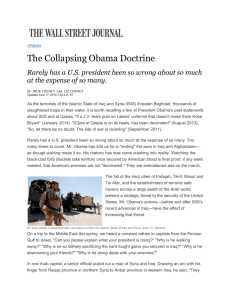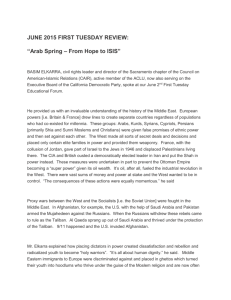ISIS and the Deceptive Rebooting of Al Qaeda
advertisement
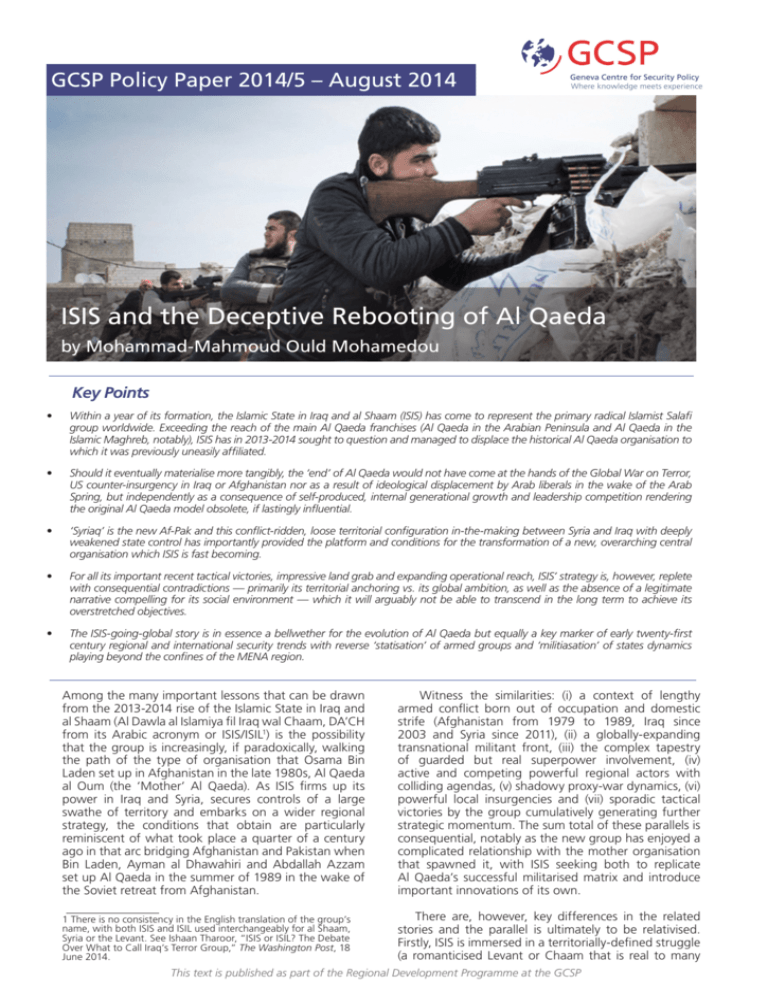
GCSP Policy Paper 2014/5 – August 2014 ISIS and the Deceptive Rebooting of Al Qaeda by Mohammad-Mahmoud Ould Mohamedou Key Points • Within a year of its formation, the Islamic State in Iraq and al Shaam (ISIS) has come to represent the primary radical Islamist Salafi group worldwide. Exceeding the reach of the main Al Qaeda franchises (Al Qaeda in the Arabian Peninsula and Al Qaeda in the Islamic Maghreb, notably), ISIS has in 2013-2014 sought to question and managed to displace the historical Al Qaeda organisation to which it was previously uneasily affiliated. • Should it eventually materialise more tangibly, the ‘end’ of Al Qaeda would not have come at the hands of the Global War on Terror, US counter-insurgency in Iraq or Afghanistan nor as a result of ideological displacement by Arab liberals in the wake of the Arab Spring, but independently as a consequence of self-produced, internal generational growth and leadership competition rendering the original Al Qaeda model obsolete, if lastingly influential. • ‘Syriaq’ is the new Af-Pak and this conflict-ridden, loose territorial configuration in-the-making between Syria and Iraq with deeply weakened state control has importantly provided the platform and conditions for the transformation of a new, overarching central organisation which ISIS is fast becoming. • For all its important recent tactical victories, impressive land grab and expanding operational reach, ISIS’ strategy is, however, replete with consequential contradictions — primarily its territorial anchoring vs. its global ambition, as well as the absence of a legitimate narrative compelling for its social environment — which it will arguably not be able to transcend in the long term to achieve its overstretched objectives. • The ISIS-going-global story is in essence a bellwether for the evolution of Al Qaeda but equally a key marker of early twenty-first century regional and international security trends with reverse ‘statisation’ of armed groups and ‘militiasation’ of states dynamics playing beyond the confines of the MENA region. Among the many important lessons that can be drawn from the 2013-2014 rise of the Islamic State in Iraq and al Shaam (Al Dawla al Islamiya fil Iraq wal Chaam, DA’CH from its Arabic acronym or ISIS/ISIL1) is the possibility that the group is increasingly, if paradoxically, walking the path of the type of organisation that Osama Bin Laden set up in Afghanistan in the late 1980s, Al Qaeda al Oum (the ‘Mother’ Al Qaeda). As ISIS firms up its power in Iraq and Syria, secures controls of a large swathe of territory and embarks on a wider regional strategy, the conditions that obtain are particularly reminiscent of what took place a quarter of a century ago in that arc bridging Afghanistan and Pakistan when Bin Laden, Ayman al Dhawahiri and Abdallah Azzam set up Al Qaeda in the summer of 1989 in the wake of the Soviet retreat from Afghanistan. Witness the similarities: (i) a context of lengthy armed conflict born out of occupation and domestic strife (Afghanistan from 1979 to 1989, Iraq since 2003 and Syria since 2011), (ii) a globally-expanding transnational militant front, (iii) the complex tapestry of guarded but real superpower involvement, (iv) active and competing powerful regional actors with colliding agendas, (v) shadowy proxy-war dynamics, (vi) powerful local insurgencies and (vii) sporadic tactical victories by the group cumulatively generating further strategic momentum. The sum total of these parallels is consequential, notably as the new group has enjoyed a complicated relationship with the mother organisation that spawned it, with ISIS seeking both to replicate Al Qaeda’s successful militarised matrix and introduce important innovations of its own. 1 There is no consistency in the English translation of the group’s name, with both ISIS and ISIL used interchangeably for al Shaam, Syria or the Levant. See Ishaan Tharoor, “ISIS or ISIL? The Debate Over What to Call Iraq’s Terror Group,” The Washington Post, 18 June 2014. There are, however, key differences in the related stories and the parallel is ultimately to be relativised. Firstly, ISIS is immersed in a territorially-defined struggle (a romanticised Levant or Chaam that is real to many This text is published as part of the Regional Development Programme at the GCSP 2 militants but which never existed administratively, as it from the mother organisation. In point of fact, the entity were) whereas the original Al Qaeda was eminently about that would become ISIS predated Al Qaeda’s mid-2000s transcending boundaries, with Afghanistan being the franchising model, which it joined in 2004 while ever springboard onto the American ‘far enemy’ (al ‘adou al chipping away at Al Qaeda’s influence and retaining the ba’eed) in lieu of the Arab regimes ‘near enemy’ (al ‘adou very functional independence that is today played out al qareeb). Secondly, the ideological component of ISIS is fully. In 1999, upon his return from Afghanistan, Jordanian thin and ranks secondarily to its identity radical Islamist Abou Mous’ab al Zarqawi (Levantine) and confessional (Sunni) To understand the rise of founded Jama’at al Tawhid wal Jihad dimensions when Bin Laden consistently ISIS that now holds territory (the Group of Unity and Jihad). Of key stressed political goals and unity among over two countries and importance is that al Zarqawi’s Afghan Islamists of all hues, including non-Arabs boasts 10,000 fighters is experience took place subsequently to and non-Sunnis. Finally, the increasing to register how it emerged and separately from that of Bin Laden. Al inroads of ISIS are mostly attracting a from the actions of the most Zarqawi had moved late to Afghanistan motley crew of fighters from around the independent lieutenant of — twelve years or so after Bin Laden and Bin Laden. world who have come to regard Syria al Dhawahiri — coming out of prison in as the new cause célèbre of Jihadism, Jordan. Setting up his own group in the whereas Al Qaeda was constructed in several stages in Asia Herat province where he led and trained some one hundred under a logic of homogenising and exporting operators Jordanians and Palestinians, away from Bin Laden’s camps and opening fronts in various other geographical centres in Qandahar, he was already making a power statement (Eastern Africa, Western Europe, North Africa, the Arabian about independence, as he had done so earlier with his Gulf). In other words, ISIS is concerned with the inwardlyown religious mentor in Jordan, Mohammad al Maqdisi, driven securing of a regional centre of gravity (coalescing from whom he had also eventually became estranged. somewhere between Fallujah, Iraq and Raqqa, Syria) for primarily regional purposes, while Al Qaeda rewrote the For all intents and purposes, al Zarqawi was in effect transnational rule book to fundamentally beam out its the first brand of ‘street Al Qaeda’. Less disciplined, more politico-religious fight internationally. Notwithstanding its violent and often terroristically more efficient, Al Zarqawi smartphone tweeting of its flag in front of the White House,2 opened space for new groups under Al Qaeda owing to his for the new group, the prize is Baghdad and Damascus. For ‘rep’ among militants. His high-profile operations (notably the older one, it was New York and Washington. the 2003 attacks in Baghdad on the Jordanian embassy and on the United Nations compound on, respectively, 7 and 19 The Origins of ISIS August) enabled his rapid and ultimately ill-fated rise,3 and signalled the onset of Al Qaeda’s faltering control of key battlegrounds such as Iraq, and, in time, the Sahel and Syria. When in the afternoon of 4 July 2014, ISIS leader Abou Omar al Baghdadi climbed the stairs of the Imam’s minbar (pulpit) — pacing himself one step at a time — to deliver the sermon In October 2004, al Zarqawi announced that his Jama’at of the Friday prayers at the Great Mosque in Mosul, Iraq, an al Tawhid wal Jihad group was merging with Al Qaeda and important moment in the saga of Al Qaeda played out. A few becoming Al Qaeda fi Bilad al Rafidayn (Al Qaeda in the days earlier, on 29 June, ISIS’ spokesman, Abou Mohammad Land of the Two Rivers, e.g., the Tigris and the Euphrates in al ‘Adnani, had announced (in a statement released in Mesopotamia, commonly known as Al Qaeda in Iraq). Upon Arabic, English, French, German and Russian) the birth of al Zarqawi’s death on 7 June 2006, he was replaced by one an ‘Islamic Abu Omar al State’ with Table 1: The Evolution of ISIS Baghdadi. From al Baghdadi that point on, Configuration Period Leader(s) (identified per Al Qaeda in Iraq Jama’at al Tawhid wal Jihad Late 1999-17 October 2004 Abu Mus’ab al Zarqawi an extended steadily entered Al Qaeda fi Bilad al Rafidayn 17 October 2004- 15 January 2006 Abu Mus’ab al Zarqawi lineage meant an even more Abu Omar al Baghdadi to establish pronounced Majlis al Shura al Mujahideen 15 January-15 October 2006 Abu Hamza al Muhajir religious Iraqi logic, briefcredentials ly merging with Islamic State of Iraq 15 October 2006- 9 April 2013 Abu Hamza al Muhajir and nobility the nationwide Abu Ayyub al Masri Abu Bakr al Baghdadi pedigree; Majlis al Shura Ibrahim ibn al Mujahideen Islamic State of Iraq and al Shaam 9 April 2013- 29 June 2014 Abu Bakr al Baghdadi Awad ibn (Advisory CounThe Islamic State 29 June 2014-present Abu Bakr al Baghdadi I b r a h i m cil of the Fightibn Ali ibn ers) in January Mohammad al Badri al Hashimi al Husayni al Qoraishi) as 2006, before becoming the Islamic State of Iraq (ISI) the “leader Caliph Ibrahim.” On 1 July, al Baghdadi himself had following October. Mustering greater militancy, Abu Omar issued a “Message to the Islamic Umma” calling on Muslims al Baghdadi would, however, lead ISI tumultuously for four from around the world to immigrate to the new Emirate. years until his death in May 2010 and his replacement by a The coincidence of al Baghdadi’s sermon with the first Friday young, Samarra-born Iraqi who had also been in Afghaniin Ramadan and with the United States’ independence day stan, Abu Bakr al Baghdadi. was hardly fortuitous, and such timing added indeed to the climactic theatricality staged by a group bringing its own To understand the significance of the mid-2014 accelerated marketisation. rise of a bellicose group that now boasts some ten thousand To be certain, ISIS’ exceptionalism within Al Qaeda’s trajectory has a long history, and it was arguably merely a matter of time before the group sought its full emancipation 2 Chris Good, “Secret Service ‘Aware’ of Apparent ISIS Flag Photo in Front of White House”, ABC News, 14 August 2014. 3 When, for example, in 2005, the former petty criminals-dominated Algerian Salafist Group for Predication and Combat (GSPC) sought to join Al Qaeda, to eventually become Al Qaeda in the Islamic Maghreb (AQIM) in September 2006, it did so through correspondence to al Zarqawi whose brashness appealed more to the group’s ways than Bin Laden’s or al Dhawahiri’s traditional conservatism. GCSP Policy Paper 2014/5 fighters (approximately seven thousand in Iraq4 and three thousand in Syria) and controls a vast territory over two countries is, first and foremost, therefore to register how ISIS rose from the deliberate action of the most fiercely independent lieutenant of Bin Laden only to be taken over by two battle-hardened local Iraqis who recalibrated the group’s orientation towards a domestic path. Such a ‘tothe-far-enemy-and-back’ indigenisation of a transnational group is today producing an uncertain transformation of a hybrid organisation in turn (re)expanding outwardly while remaining wedded to local goals. Unseating Al Qaeda al Oum It is equally important to reconstruct the recent revealing sequence whereby, in spite of this inherent emancipation orientation, a moribund ISI in 2008-2011 has by now overtaken Al Qaeda in the Islamic Maghreb (AQIM) and Al Qaeda in the Arabian Peninsula (AQAP) in the dangerosity rankings of Western security experts5, and is now on its way to quite paradoxically morph into an Al Qaeda al Oum-like leading entity with wide transnational ambitions. disavowed the ISI-al Nusra merger (“Sheikh Abu Bakr al Baghdadi was wrong when he announced the Islamic State in Iraq and the Levant without asking permission or receiving advice from us and even without notifying us… The Islamic State in Iraq and the Levant is to be dissolved, while the Islamic State in Iraq is to continue its work”) and called anew for ISIS’ disbandment the following 7 November. This sequence is unprecedented in the annals of Al Qaeda, and is in fact indicative foremost of the roughand-ready threat ISIS came to overnight represent to Al Qaeda al Oum. Never before had Al Qaeda aired out its disagreements so explicitly and never before had its leadership been questioned so openly and its lack of control over matters revealed so plainly. Above and beyond the contestation, this was arguably a revealing moment of the end of a cycle. Simply put, al Dhawahiri had failed to inherit Bin Laden’s leadership. In reality, however, ISIS’ move was more complex and just as well due to “Sunni marginalisation by the Iraqi government, the extreme incompetence of the Iraqi Security Forces and a major change in ISIS operational tactics.”7 In the event, ISIS was indeed motivated by its provincial ambition, the unexpected opportunity provided by the Syrian conflict, the deterioration of the Iraqi situation under Prime Minister Nuri al Maliki’s rule and by the post-Bin Laden indecisiveness on the part of Al Qaeda al Oum. In the interregnum between the disappearance of Osama Bin Laden in May 2011 and ISIS’ April 2013 rise, there materialised a transition period wherein the global soldiery of Al Qaeda was looking more for strategic direction than for a cause. What was to become of the To be certain, Al Qaeda is hardly dead; the regional organisation the Saudi millionaire had set up? Where was command structure still exists and any it heading after the fall of its iconic leader? failure of ISIS is likely to immediately What should the priorities be as uprisings and upheaval proliferated unceasingly around the ‘Syriaq’ is the new Af- benefit Al Qaeda. Indeed, one should Middle East and North Africa? While Arab Pak and this conflict- neither overestimate the Islamic 3 configuration State’s strengths nor underestimate al Spring-driven analyses decreed the end of ridden with Qaeda’s.8 For the time being, Al Qaeda, the Al Qaeda6 and Bin Laden’s deputy Ayman in-the-making deeply weakened state in one form or another, is a permanent al Dhawahiri sprang forth as new formal is providing feature of the new grammar of global but impotent leader, a global Jihadist power control the conditions for the security not a fleeting influence on vacuum deepened. transformation of ISIS. MENA politics. It took two years for the dust to settle. In that regard, a key element in the evolution of the On 9 April 2013, recognising an opportunity dovetailing Al Qaeda-ISIS contest will be the positioning of the other the crisis in Syria, Abu Bakr al Baghdadi stepped out to power houses in the Al Qaeda constellation, notably announce the creation of the Islamic State of Iraq and AQAP and AQIM. Neither groups have yet adopted a al Shaam — in effect adding Syria to his existing Iraq clear-cut position but resentment of ISIS is palpable. On dominion. In that statement, al Baghdadi declared that 14 July 2014, AQIM leader Abdelmalek Droukdel rejected the anti-Bashar al Assad Syrian rebel group Jabhat al ISIS’ call and reaffirmed his allegiance to al Dhawahiri. Nusra (the Front of Victory), set up in January 2012, was Yet, on 25 June, the head of AQIM’s Central Zone had joining his movement as the local Syrian branch of ISI. Yet, announced his support to ISIS. Similarly, the founder of the next day, Jabhat al Nusra’s leader Abu Mohammad AQIM off-shoot Jama’at al Tawhid wal Jihad fi Gharb al Jolani rejected the integration stating that “neither Ifriqiya (the Movement for Unification and Jihad in West the al Nusra command nor its consultative council nor its Africa, MUJAO), Hamada Ould Mohamed Kheirou, had general manager were aware of this announcement. It expressed on 11 July his support of the Islamic Caliphate, reached them via the media and if the speech is authentic, as did, on 13 July, Aboubakr Shekau, the leader of Boko we were not consulted.” This then led to a split within al Haram. For its part, and while being enmeshed in the Nusra, a wing of which opted for integration into ISIS, Yemeni transition, AQAP has remained officially silent which also secured the support of Harakat Ahrar al Shaam but, revealingly, its leader, Nasser al Wuhayshi, issued on 3 (the Movement of the Free Men of the Levant), another July a poem praising al Dhawahiri and implicitly criticising powerful rebel group set up in Syria in 2011. Stepping ISIS’ pronouncements, although again AQAP commander in to settle the dispute, on 23 May, Ayman al Dhawahiri Sheikh Makmun Hatim had previously indicated support 4 Of these, about 1,000 are from the post-Soviet space, 1,500 from to ISIS. Finally, the rising forces in Egypt, Ansar Beit al Saudi Arabia, 2,000 from Jordan and 2,500 from Iraq. Maqdis (Partisans of the Holy House), and in the Libya 5 On AQAP, see, for instance, Alexander Meleagrou-Hitchens and and Tunisia, Ansar al Sharia (Partisans of the Sharia), are Peter R. Neumann, “Al Qaeda’s Most Dangerous Franchise”, The Wall operationally close to ISIS and likely to align with it but Street Journal, 10 May 2012, p. A1. 6 See, for instance, Michel Moutot, “A Year after Bin Laden Slain, have not yet taken unambiguous positions on the matter. Al Qaeda ‘in Ruins’”, AFP, 29 April 2012; and Michael S. Schmidt and Eric Schmitt, “Leaving Iraq, US Fears New Surge of Qaeda Terror,” The New York Times, 5 November 2011, p. A1. Schmidt and Schmitt offered that the Islamic State of Iraq was “unlikely to regain its prior strength.” 7 Hasan Shafqat, “Examining the Causes of the Islamic State’s Resurgence in Iraq,” Tahrir Soury, 16 June 2014. 8 Daveed Gartenstein-Ross and Thomas Joscelyn, “Zawahiri’s Revenge,” Foreign Policy, 31 July 2014. GCSP Policy Paper 2014/5 All in all, the jury is still out. The Paradoxes of ISIS 4 As we find ourselves at a key moment in the evolution of the armed groups evolving in the larger Middle East and North African area, the ISIS story must in turn be located in a wider history not of its making and, in fact, far removed from its motivations and methods. The materialisation of ISIS owes also a lot to the changing contexts of politics in the region. This, in effect, is the third phase in an interlocked scene in which postcolonial battles generated a first transnational moment in the 1970s. In that respect, Bin Laden was not the first one to introduce a globally-oriented struggle. The first ones to do so were the Palestinians and a first transnational moment — albeit a secular one of a national struggle for liberation — had importantly taken place in the earlyto-mid-1970s.9 The birth of Al Qaeda in the wake of the Afghanistan war led to the rise of a second more effectively transnational moment with completely different radical Islamist motivations. As Al Qaeda al Oum began receding in the late 2000s and early 2010s and as the Syrian uprising mutated into a civil war, a third global moment was born, again for different reasons but building on the same state-weakening grammar as the previous wave. Whereas the Palestinian guerrillas had straightforward national liberation motivations and Bin Laden’s agenda was politico-religious, ISIS’ motivations are neither clear nor compelling to their soldiery. In effect, the motivations are circumstantial and derivative. Martial dynamics such as resistance (muqawama) and fight (nidal) in the 1970s and 1980s and jihad (struggle) in the 1990s and 2000s have been replaced by control and dominion logics of dawla (state) in the 2010s. Yet, although it is striking alliances in the revolts in Iraq and Syria and feeding off the neo-fitna (strife/dispute) between Sunna and Shia in the Muslim world, ISIS is not actually launching a global offensive on many fronts as it is posturing and dependent on acceptance of this stance by allies and foes alike. As they did elsewhere (notably in the case of AQIM using the 2012 Libya situation to move further into Mali), the extremists are capitalizing on a situation (i.e., Syria) not of their making. In so doing, ISIS has also two examples of failed management to look at; the Taliban in Afghanistan and AQIM & co. in the Sahel. Both punitive approaches to the relations with the locals proved fatal to the groups. ISIS has clearly behaved in Syria in a mode akin to AQIM in Mali. Missing an enabling environment and readymade acceptance, it has stretched artificially its connections with 9 On this key period, see Paul Thomas Chamberlin, The Global Offensive – The United States, the Palestine Liberation Organisation, and the Making of the Post-Cold War Order, Oxford University Press, 2012. the locals and relied on ruthless and violent control. Such “combination of force, clientelism and manipulation of local rivalries”10 is thus an objective limitation to its longterm impact. In contradistinction, Al Qaeda was born out of a bureau of assistance in Afghanistan (Maktab al Khadamat lil Mujahideen). Finally, whereas the environmentally-enabled mode of asymmetric warfare has been gaining in strength with Hezbollah now a regional military powerhouse11 and Hamas walking in its footsteps — the Israeli military is demonstrably on a losing pattern in facing this type of non-state Arab enemy, as witnessed in the July-August 2006 and the JulyAugust 2014 engagements — the ISIS/AQIM authoritarian alienating approach has proven militarily unsuccessful in the Sahel and for now open to question in the Levant. Indeed, were it not for the tribal support in Iraq and the presence of other groups battling the regime in Syria for their own non-Islamist reasons, ISIS’ strength might not have been sufficient to change so radically the dynamic in the ‘Syriaq’ region. It is no small paradox that, benefitting from the most globalised context ever, ISIS has behaved eminently locally. ISIS has capitalised on an objective attraction phenomenon of Syria whereby fighters are coming from other regional groups, from the diasporas in the West and from their ancestral homes. Amid these reinvented possibilities, each of these arrivals has several layers of motivations. Such ambiguity certainly tactically serves ISIS, as is notably the case with Caucasian and Chechen groups,12 but it does not necessarily furthers its larger goals. This then begs the important question of whether ISIS is ultimately not merely a ‘super Sunni’ group. For indeed, in 2007, the Sunni Sahwa (Awakening) tribal movement defeated ISI in high-profile engagements in the Diyala and Anbar provinces, and, seven years later, Sunni tribal revolt against al Maliki enabled ISIS’ rise. Yet alliance with the Sunni tribes cannot last and talk of khilafa (caliphate) is not reconcilable with Iraqi wataniya (patriotism). Tellingly, the Shiite aspect was not problematic for Al Qaeda al Oum and Bin Laden was always careful not to alienate Shiites explicitly reprimanding al Zarqawi in 2005 for his attacks on the Shia. That, however, was a different context before Saddam Hussein’ December 2006 hanging amidst Shiite religious chants, which marked a turning point in the conflict between Sunnis and Shiites. 10 Felix Legrand, “The Colonial Strategy of ISIS in Syria”, Policy Alternatives, Arab Reform Initiative, June 2014, p. 1. 11 See Shai Oseran and Stéphane Cohen, “Don’t be Fooled – Hezbollah is Bigger and Badder than Ever,” The Tower, 12, March 2014; and Isabel Kershner, “Israel Watches Wearily as Hezbollah Gains Battle Skills in Syria,” The New York Times, 10 March 2014, p. A1. 12 See Guido Steinberg, “A Chechen Al Qaeda?,” SWP Comments 31, June 2014. GCSP Policy Paper 2014/5 Contextualising ISIS ISIS leader Abu Bakr Al Baghdadi is closing the Bin Laden era, displacing Aymen al Dhawahiri and self-proclaiming himself as Caliph (“I have been plagued with this great matter, plagued with this responsibility and it is a heavy responsibility” he said in his 4 July address). Yet framing ISIS merely within the logic of a conflict with Al Qaeda would be missing on the objective importance of the group. Though the rise of ISIS is a novel phenomenon which must be properly historicised, as has been often the case when it comes to Al Qaeda, the rise-and-fall matrix has been dusted off anew and the qualitative importance of the ISIS story lost in the waning and waxing framing. As Patrick Cockburn noted: “The very speed and unexpectedness of [ISIS’] rise make it easy for Western and regional leaders to hope that the fall of ISIS and the implosion of the Caliphate might be equally sudden and swift. But all the evidence is that this is wishful thinking.”13 Both territorial consolidation and global ambition were displayed early on by ISIS.14 Just as Al Qaeda was an emanation of both globalisation and transnationalism in the late 1980s and early 1990s, ISIS circa 2010s is a testimony to the mutating manifestation of international insecurity in the form of weakened states, increasingly ‘militiased’ in the Levant, and of those ‘ungoverned spaces’15 that have been materialising in the Middle East and in Africa, and elsewhere. And so, just as al Baghdadi expresses a desire to unite (“It is time for you to end this abhorrent partisanship, dispersion, and division”), the strategy against his group is one meant to develop or exploit fissures16 within the group as it builds up momentum towards expansion. In that respect, ISIS shares an important commonality with Al Qaeda al Oum. It is its very existence not its strategy or cadence that is offsetting its enemy, and so bombings such as those ordered by US President Barack Obama in August 2014 are likely to achieve little in this context. Reflecting on the relevance of Von Clausewitz to the Arab Revolt he took part in Arabia a century ago, T.E. Lawrence captured such key marker of asymmetrical engagement: “Clausewitz had said that rearguards modulate the enemy’s action like a pendulum, not by what they do, but by their mere existence.”17 13 Patrick Cockburn, “ISIS Consolidates”, The London Review of Books, 36, 16, 21 August 2014, p. 3. 14 See Aymenn Jawad al Tamimi, “The Islamic State of Iraq and AshSham’s Messages and Self-Presentation in Syria and Iraq”, Jihadology, 9 September 2013. 15 See Anne L. Clunan and Harold A. Trinkunas, eds., Ungoverned Spaces – Alternatives to State Authority in an Era of Softened Sovereignty, Stanford, California: Stanford University Press, 2010. 16 Eric Schmitt and Alissa J. Rubin, “U.S. and Iraqis Try to Fragment Extremist Group”, The New York Times, 12 July 2014, p. A1. 17 T.E. Lawrence, “The Evolution of a Revolt”, The Army Quarterly and Defence Journal, October 1920, p. 4. In the final analysis, ISIS is the natural culmination of the US intervention in Iraq, Maliki’s authoritarianism, Assad’s ruthlessness and post-Bin Laden Al Qaeda’s discomposure. The question is less the pull of ISIS in the eyes of its militants or its grand-standing towards the Umma than its real reach and impact on the ground. As al Baghdadi reintroduced the street style of al Zarqawi and focused on prison breaks to staff his group with ruthless operators, he also pursued a centralised conquer-and-hold approach to seize territory instead of an open ended evanescent insurgency. Tested in Iraq in 2012-13, the strategy was then applied in Syria.18 With the ‘Islamic State’ announcement in 2014, this is now coupled with “symbolic state-building”19 overreaching claims. The ISIS story thus indicates that for all the decentralisation, there remains among Jihadis a yearning for a global leadership, as it once existed under the heyday of Bin Laden’s Al Qaeda al Oum (1995-2005). ISIS is certainly filling a vacuum and regenerating a brand that was successful among those militants. Yet, without establishing a modicum of political legitimacy, ISIS will not be able to build an enduring movement. The franchising was accepted because it was decreed by Bin Laden and it made sense tactically as Al Qaeda also avoided structural collapse by welcoming generational shift. Al Qaeda who tellingly refers to itself officially as Qaedat al Jihad (the basis of the Jihad) saw itself as an enabler, whereas ISIS’ centrifugal dynamics indicate otherwise revealing the limits of the franchise model. Al Baghdadi’s in-your-face ruthlessness is the consequence of the urgency of the battle scene he inhabits and the outcome of his mixed-results, battle-hardened management of ISI since 2006. The violent campaign he is orchestrating may or may not be lasting but it is undeniably a qualitative milestone in the larger Al Qaeda story. If admittedly most insurgent groups are born from pre-war politics,20 both Al Qaeda and ISIS are, for their part, forged in war. The martiality that hence characteristically presided over the birth of Al Qaeda is precisely what is allowing the Islamic State to take Bin Laden’s legacy, ‘Al Qaedism’, to the next level. August 2014 18 See Charles C. Caris and Samuel Reynolds, “ISIS Governance in Syria,” Institute for the Study of War, 1 August 2014. 19 Yezid Sayigh, “Da’ach: Khilafa Islamiya ‘Alamiya am Douaila Islamiya fil Iraq” (“ISIS: Global Islamic Caliphate or Islamic Mini-State in Iraq?), Al Hayat, 24 July 2014. 20 Paul Staniland, Networks of Rebellion – Explaining Insurgent Cohesion and Collapse, Ithaca: Cornell University Press, 2014, p. 217. NB: This paper is solely the opinion of the author and does not necessarily reflect the official view of the GCSP. About the author Mohammad-Mahmoud Ould Mohamedou is Deputy Director and Academic Dean of the Geneva Centre for Security Policy and Visiting Professor at the Graduate Institute of International and Development Studies in Geneva and at Sciences Po Paris. He is the author of Understanding Al Qaeda – Changing War and Global Politics (2011). GCSP Policy Papers are available at www.gcsp.ch The Geneva Centre for Security Policy (GCSP) is an international training centre for security policy based in Geneva. An international foundation with over 40 member states, it offers courses for civil servants, diplomats and military officers from all over the world. Through research, workshops and conferences it provides an internationally recognized forum for dialogue on issues of topical interest relating to security and peace policy. GCSP Policy Paper 2014/5 5

